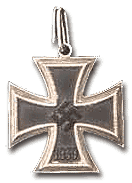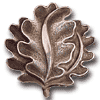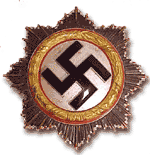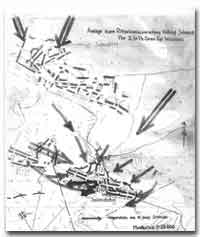Kommandeur II./SS-Pz.Gren.Rgt. "Westland"
5.SS-Pz.Div. Wiking

(image sources on image tags)
Träger des Eichenlaubes zum Ritterkreuz des Eiserne Kreuze (479.)
SS-Hauptsturmführer Walter Schmidt
Kommandeur II./SS-Pz.Gren.Rgt. "Westland"
5.SS-Pz.Div. Wiking

(image sources on image tags)
Träger des Eichenlaubes
zum Ritterkreuz des Eiserne Kreuze (479.)







Walter Schmidt's decorations include the Iron Cross 2nd Class (20 September 1939 in Poland), the Iron Cross 1st Class (14 September 1941 in Russia), Knight's Cross to the Iron Cross (4 August 1943), Oakleaves to the Knight's Cross of the Iron Cross as 479th soldier (14 May 1944), the German Cross in Gold (9 April 1943), the Close-Combat Clasp in silver and the Wound Badge in Gold.
Walter Schmidt, son of the Kriminalsekretär Karl Schmidt, was born on 28 January 1917 in Bremen. On 2 May 1935, after attending the Volksschule and working as a salesman, Walter Schmidt joined the SS-Regiment "Germania." From 1937-1938, Schmidt attended the SS-Junkerschule at Bad Tölz. On 9 November 1938, Walter Schmidt was promoted to SS-Untersturmführer. His assignments included Zugführer 6./ and 13./SS-Germania, Bataillon-Adjutant II./Germania, wounded in the west, Kompanieführer der Ersatzbataillon, and in November 1940 Kompanieführer 13./Nordland. On 1 June 1904, Walter Schmidt was promoted to SS-Obersturmführer. On 30 January 1942, Schmidt was promoted to SS-Hauptsturmführer. On 1 August 1942, Schmidt was assigned as Rgt.Adj.m Westland. From 27 January 1943 until 30 April (date of citation), Schmidt was assigned as the Btl.Kdr.II./Westland.
Combat Action
on the Eastern Front
for the award of the Knight's Cross
Originated from locations
on either side of Tscherwonyj Schachter, the Soviets planned to break through
west of Issjum and drive on Barwenkowo. During the attack the Soviets succeeded
in gaining the village of Sawodskoje that lay south of Tscherwonyj Schachter.
Once the village was recaptured by friendly forces, the II./SS-Pz.Gren.Rgt.
"Westland", under the command of SS-Hauptsturmführer Walter Schmidt, was tasked
with the defense of Sawodksoje.
A critical situation developed for the defending "Westland" Regiment after enemy
units had penetrated the eastern and western areas of Sawodskoje. Holding the
village was of great consequence that offered the last areas for observation
onto the bridgeheads and crossings to Tscherwonyj Scahchter. Moreover, the Soviet's
lines of communication between the eastern and western spearheads remained severed
as long as Sawodskoje remained in German hands. Thus, sufficient Soviets infantry
and tank forces were assembled for the capture of Sawodskje. Every Soviet attack
was thwarted throughout 2 days of bitter fighting and counterattacks. During
the fighting on 19 July 1943, SS-Hauptsturmführer Schmidt distinguished himself
as soon as Soviet forces, supported by tanks, had infiltrated the southeastern
portion of Sawodskoje. With only a hand full of men, the Btl.-Führer Schmidt
launched a calculated counter attack that eliminated the enemy penetration.
In close combat, man for man and led by the Btl.-Führer Schmidt, the enemy was
pushed out of Sawodskoje. In the process, several Soviet tanks were destroyed
in close combat.

Click on map for a high-resolution reference-map.
On 20 July 1943, the number of Soviet attacks became more and more frequent. Heavy artillery fire, in conjunction with several slavo-rocket projectors, laid preparatory fire for the coming attack. However, this attack was repulsed by the personal bravery of SS-Hauptsturmführer Schmidt. Despite the success, a second crisis developed in the evening on 20 July 1943 when Soviet infantry, supported by tanks, managed to infiltrate the western portion of the Sawodskoje. Once again, Schmidt counterattack with a handful of men and ejected the Soviets altogether. SS-Hauptsturmführer Schmidt's personal bravery an exemplarily initative allowed the II./SS-Pz.Gren.Rgt "Westland" to hold the village of Sawodskoje, repell every Soviet attack, and prevented the planned Soviet breakthrough. The German retension of Sawodskoje provided for artillerry observation that was of utmost importance for the continuation of fighting and capture of Tscherwonyj Schachter. The resupply and replacement of Soviet forces was severly hampered through the observed fire of heavy artillery. There is cause to believe that SS-Hauptsturmführer Schmidt's decision to hold Sawodskoje, to the very last man, had a tremendous impact on the overall course of battle. Gained too was valuable time that allowed for the reorganization of the German defense and to prevent a conserted Soviet attempt to breakthrough toward the south in the direction of Barwenkowo.
SS-Hauptsturmführer Schmidt participated in the campaigns in Poland, France, and in the east. On every occassion, Schmidt proved his worth as a brave, conscientous, and cold-blooded oficer who managed to triumph in every operational crisis. To his men he represents the epidomy of "combat ready." His achievements of the past merited recognition with the award of the Iron Cross 1st Class and the German Cross in Gold. SS-Hauptsturmführer Schmidt's achievements, during the defensive battles west of Issjum, warrant the decoration of the Knight's Cross to the Iron Cross.
On 30 November 1943, strong Soviet forces crossed the road Tscherkassy-Smela. The Btl.-Schmidt was augmented with eastern lying elements of the 42.Jäger-Division. The objective was the capture of 2 distantly separated farms. The Soviets had entrenched strong infantry forces within the farms and the outlying corn fields. As a result of earlier fighting, the II.Batl. "Westerland" was considerably weakened so that the German attack ground to a halt in the face of determined defensive fire. Unable to lead his men forward as a result of the uneven terrain, SS-Hauptsturmführer Schmidt sprang on top of a destroyed tank, unconcerned of enemy fire, and rallied his men forward. Encouraged by the actions of the Btl.-Führer, the attack was resumed and succeeded in reaching not only the attack objective, but driving 3 km-deep through the enemy lines. The successful attack resulted in a 3-day suspension of Soviet initiatives against the main road. The brief respite allowed for a new security line to be establsihed west of the road.
In the pocket southwest of Tscherkassy, SS-Hauptsturmführer Schmidt displayed his exceptional worth on a daily basis. Despite the high number of casulaties, Schmidt's personal bravery, determination, and outstanding leadership led to the overall regimental defensive victory after the battles of Buda'Orloswezkaja, Mlejew, Skiti, Tscherepin, Derenkowez, Arbusino, and west of Korssun. Even the inexperience of the infantrymen, from the attached Panzerjäger- and Flak-Abteilungen, was directed in such a fashion that every attack was defeated by the inexperienced troops.
Combat Action
on the Eastern Front
for the award of Oak Leaves to the Knight's Cross
From 24-30 November 1943, the II./SS-Pz.Gren.Rgt. "Westland", operating in conjunction with the 72.Jägerdivision, was committed southeast of Tscherkassy as a blocking force. On 28 November, the II.Bataillon was ordered to attack and capture the brickworks-terrain southeast of Tscherkassy from positions in Smogailowka. The northwestern area of Smogailowka, ordered as the assembly area for the impending attack, was suddenly occupied during the morning hours on 28 November by strong Soviet infantry forces. Within the brickworks-terrain alone, a Soviet assembly area consisting of 20 tanks was detected. Moreover, strong infantry forces were also assembling in the corn fields north of the brickworks.
The threat of a renewed and imminent Soviet attack, in order to expand the Soviet bridgehead, was recognized by SS-Hauptsturmführer Schmidt. Deciding not to wait for the arrival of a small tank group for support, Schmidt launched a spoiling attacked with the support of a single S.IG.-Zug (heavy infantry field gun or howitzer- platoon). As a result, the northwestern area of Smogailowka was cleared of enemy forces and advanced into the northeastern portion of the brickworks. The Soviets were taken by complete surprise and the following materiel was captured by the II.Bataillon:
2 field guns 7,62 cm
3 anti-tank guns 4,7mm
21 anti-tank rifles
18 machine guns
60 submachine guns
83 rifles
One officer and 13 men were captured and approximately 300 dead Soviets were
counted.
At the onset of the attack, the II./Bataillon reported a combat strength of 130 Unterführer and men whose mass consisted of the recently arrived seven-citizen recruits (Denmarck, etc.) that received their baptism of fire. The success of the spoiling attack is mainly due to the exceptional fighting spirit and personal bravery of SS-Haupsturmführer Schmidt, who recognized the Soviet threat and led by example at the very front of his men.
On 30 November 1943, strong Soviet forces crossed the road Tscherkassy-Smela. The Btl.-Schmidt was augmented with eastern lying elements of the 42.Jäger-Division. The objective was the capture of 2 distantly separated farms. The Soviets had entrenched strong infantry forces within the farms and the outlying corn fields. As a result of earlier fighting, the II.Batl. "Westerland" was considerably weakened so that the German attack ground to a halt in the face of determined defensive fire. Unable to lead his men forward as a result of the uneven terrain, SS-Hauptsturmführer Schmidt sprang on top of a destroyed tank, unconcerned of enemy fire, and rallied his men forward. Encouraged by the actions of the Btl.-Führer, the attack was resumed and succeeded in reaching not only the attack objective, but driving 3 km-deep through the enemy lines. The successful attack resulted in a 3-day suspension of Soviet initiatives against the main road. The brief respite allowed for a new security line to be established west of the road.
In the pocket southwest of Tscherkassy, SS-Hauptsturmführer Schmidt displayed his exceptional worth on a daily basis. Despite the high number of casulaties, Schmidt's personal bravery, determination, and outstanding leadership led to the overall regimental defensive victory after the battles of Buda'Orloswezkaja, Mlejew, Skiti, Tscherepin, Derenkowez, Arbusino, and west of Korssun. Even the inexperience of the infantrymen, from the attached Panzerjäger- and Flak-Abteilungen, was directed in such a manner that every attack was defeated by the inexperienced troops.
During the breakout of the pocket, SS-Hauptsturmführer Schmidt distinguished himself yet again. The II.Btl. marched to within 800 meters northwest of Hill 193,3 where a strong blocking force established. During a German assault along the northern outskirts of the forest, where Soviet positions had been prepared south of Dshurshenzy, 1 anti-tank and 2 machine guns were captured and an enemy attack from Dshurshenzy was repulsed. An immediate counterattack threw the Soviets as far back as the church that allowed the first German forces to reach the main road southeast of Hill 239. Furthermore, contact with friendly forces outside of the pocket was reestablished through the woods west of Potschapinzy.
In the meantime, larger groups
of Army personnel were absorbed into the weakened Kampfgruppen with a common
objective of breaking out of the pocket. Leading the assault of approximately
300 men, Schmidt stormed northwestward the woods at Lissjanka. Following his
lead, several more assault groups followed that provided enough momentum to
reach friendly lines. For this action, SS-Hauptsturmführer Schmidt was awarded
oak leaves to the Knight's Cross of the Iron Cross.
Copyright Stenger Historica 2003